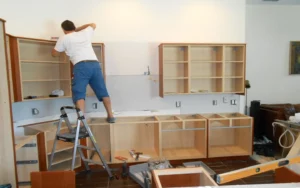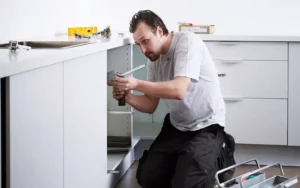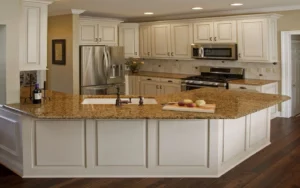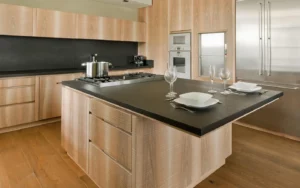Venturing into the world of kitchen upgrades can often feel overwhelming, especially if it’s uncharted territory for you. Central to any kitchen makeover is the placement of new cabinetry – a critical aspect that shapes your culinary space’s overall aesthetics and functionality. With a pinch of perseverance, a selection of the right tools, and a solid understanding of the processes at hand, setting up kitchen cabinets can metamorphose your kitchen into a visually appealing and high-performing workspace. Now, let’s delve into the captivating and complex realm of cabinetry setup.
Setting the Stage for Installation
Before beginning the installation process, it’s important to understand that a well-organized workspace is crucial. A clear and concise plan will save you time and unnecessary frustration.
The Right Cabinet Choice
Before diving into the procedure, it’s crucial to have handpicked the most fitting cabinets for your kitchen. The choices are varied in terms of style, substance, and expense. Whether you lean towards ready-to-assemble (RTA) cabinets or prefer customized ones will largely depend on your budget and design inclinations.

Assembling the Tools and Supplies
Accumulate all the required tools and supplies, including a level, stud finder, drill, screws, pencil, tape measure, and shims. Having everything at arm’s length helps to ward off unnecessary interruptions midway through the installation.
Read more about kitchen cabinet types
Crafting a Layout Plan
Conceive a blueprint or plan for your kitchen’s layout. Take accurate measurements of the walls, windows, and appliances to dictate where each cabinet should be placed. Scribble the proposed locations of the cabinets on the wall to act as a guide during the installation.
The Process of Cabinet Installation
Fitting the Upper Cabinets
This process includes:
Mounting the Ledger Board
It’s practical to commence with the upper cabinets. Fix a ledger board—a makeshift support structure—on the wall to prop up the cabinets during installation.
Affixing the Cabinets
Then, line up the first cabinet with the ledger board and the demarcated lines on your layout. Once positioned correctly, bore holes through the back of the cabinet into the wall studs and secure it using screws. Use a level to guarantee that the cabinet is flawlessly horizontal.

Linking Cabinets
If your plan includes multiple wall cabinets, these need to be interconnected. Clamp together the stiles (the vertical pieces at the front) of the neighboring cabinets, then drill and screw them together. Ensure they are perfectly flush and level before locking them in place.
Fitting the Base Cabinets
Fitting the base cabinet involves leveling, securing, aligning, and anchoring.
Leveling and Securing
Unlike wall cabinets, base cabinets are located on the floor and must be precisely leveled. Place the first base cabinet in the designated spot. Utilize shims to tweak the cabinet’s level from front to back and side to side. Once leveled, drill holes and secure them to the wall studs using screws.

Aligning and Anchoring
For several base cabinets, ensure the fronts are aligned and clamp them together. Verify their level and make adjustments if needed before securing them together.
Post-Installation Tasks
This process includes;
Fitting Doors, Drawers, and Hardware
With all the cabinets firmly installed, it’s time to fix the cabinet doors and slot them in the drawers. The hardware—knobs or handles—can be fitted as you like.
Clearing Up
Remove the ledger board and any leftover materials. Ensure all screws are correctly tightened, and the cabinet doors and drawers operate seamlessly.
Getting to Know Your Cabinet
This stage is just as important as the installation itself. You’ve successfully installed your cabinets, but there’s still work to ensure everything is perfect and ready for use.
Essential Cabinet Parts
Familiarizing yourself with the basic parts of your cabinets will enable you to manage the installation process better. Kitchen cabinets primarily comprise boxes, doors, and drawers. The box is the main framework of the cabinet, while the doors and drawers facilitate access to the storage area inside.
Unique Features
Cabinets may feature special elements such as pull-out shelves, spice racks, or wine holders. Awareness of these features will aid you during assembly and installation, ensuring these components are accurately placed.
Learn more about high-end cabinets
Safety Precautions
Before we begin, let’s remember that safety always comes first. The precautions you take at this stage can prevent accidents, saving you from injury or harm.
Safety with Power Tools
The use of power tools can be hazardous if not used cautiously. Always don safety glasses and gloves to shield your eyes and hands. Unplug tools when switching bits or making adjustments.
Lifting Safety
Cabinets can be weighty and difficult to maneuver. Always lift using your knees, not your back, and seek help when lifting sizeable cabinets. Employing a cabinet jack or support system can make the process safer and more manageable.
Incorporating Personalized Elements
Here we provide you with some ways to personalize your kitchen.
Illumination
Under-cabinet lighting can provide functionality while enhancing the ambiance of your kitchen. If you intend to incorporate such lights, arrange for the necessary wiring during the cabinet installation.
Molding and Trim Details
Introducing crown molding or trim can give your cabinets a unique, polished appearance. These should be accurately cut, painted, or stained to blend with your cabinets before they are affixed.
Preserving Your Cabinets
Personalization can bring an added touch of elegance and functionality to your kitchen. Paying attention to minute details can make a difference in the outcome.
Regular Cleaning
Preserve the shine of your cabinets by cleaning them with gentle, non-abrasive soap and water concoction for routine cleanups. Avoid exposure to excessive moisture and promptly wipe the surfaces dry using a soft cloth.
Repairs and Touch-ups
Over time, your cabinets might display signs of wear and tear, such as minor damages, scratches, or chips. Maintain a touch-up kit for minor mends, and be aware that deeper scratches or dents might necessitate professional intervention.
Efficient Use of Kitchen Space
Optimizing your kitchen space requires both creativity and practicality. Every detail plays a crucial role, from your cabinets’ interiors to your appliances’ strategic placement.

Organizing Cabinet Interiors
Expand your cabinet storage capacity by installing organizers such as pull-out racks, lazy Susans, and adjustable shelves. These enhancements can contribute to a neat, functional kitchen.
Integration of Appliances
Certain kitchen appliances, including dishwashers, microwaves, and ovens, can be seamlessly incorporated into the cabinets for a more streamlined look. Still, they should be contemplated during the initial planning phase.
Addressing Typical Installation Challenges
During any installation process, challenges are inevitable. The key to overcoming these lies in foreseeing possible issues and having practical solutions.
Imperfect Floors and Walls
Not all floors and walls are perfectly level or flat. Resort to shims to make necessary adjustments and level the cabinets as required.
Misaligned Doors and Drawers
If the cabinet doors and drawers aren’t aligning adequately, use the adjustment screws on the hinges or slides to make minor amendments until everything is perfectly aligned.
Enhancing Cabinet Lifespan
Once the cabinets are installed, prolonging their life and maintaining their appearance is important. Regular upkeep and sensible usage are paramount in this regard.
Regular Inspections
A periodic inspection of your cabinets for loose screws, hinges, or any signs of damage can help avert minor problems from escalating into significant issues. Tighten any loose components and address any structural concerns promptly to extend the life of your cabinets.

Prevent Overloading
Cabinets, especially the wall-mounted ones, have a weight limit. Overburdening them can lead to damage to the shelves or the mounting system. Always spread weight uniformly and avoid storing excessively heavy items in one location.
Planning for Plumbing and Wiring
Considering the plumbing and wiring of your kitchen during the cabinet installation process is crucial. Careful planning can ensure a smoother process and prevent costly mistakes.
Plumbing Provisions
For sink base cabinets, planning for plumbing fixtures is essential. Ensure you have cutouts at the appropriate spots for the plumbing lines to pass through. Always remember to turn off the water supply when working around these areas.
Electrical Appliance Arrangements
For cabinets that will accommodate or be near electrical appliances, it’s crucial to plan for outlets and wiring. Any required holes should be drilled before installation, and all wiring should adhere to local safety regulations.
Adjusting to Different Cabinet Styles
Different cabinet styles add a unique touch to your kitchen decor and come with distinct installation techniques. It’s essential to adapt your approach based on the style you’ve chosen.
Frameless Cabinets
Also known as European-style cabinets, frameless cabinets afford more access to the cabinet interior but necessitate precise installation. The process remains largely unchanged, but the absence of a face frame makes it critical to ensure your walls are flat and that cabinets are perfectly level and plumb.
Specialty Cabinets
These can include corner cabinets, pantry units, or appliance garages. Each may come with unique installation requirements, so always adhere to the manufacturer’s instructions. However, the foundational principles of level, plumb, and secure attachment remain constant.
Adopting Green Practices in Cabinet Installation
Adopting sustainable practices in your cabinet installation process benefits the environment and contributes to a healthier living space. From the materials you choose to the way you handle waste, every step counts.
Sustainable Materials
Consider choosing cabinets constructed from sustainable materials or recycled wood products to help lessen your environmental footprint and provide the added advantage of reduced volatile organic compound (VOC) emissions.
Eco-friendly Recycling and Disposal
If replacing old cabinets, consider donating them to a reuse center or reselling them instead of sending them to a landfill. If they’re unfit for reuse, explore local alternatives for recycling or disposing of them in an environmentally friendly manner.
In Conclusion
While installing kitchen cabinets may initially seem overwhelming, a structured and innovative approach can successfully guide you. It allows you to create a bespoke space that caters to your needs and mirrors your style. So, strap on your tool belt, step into your kitchen, and rise to the challenge. The reward will be a kitchen you’ll cherish for many years.
KEYWORDS:
